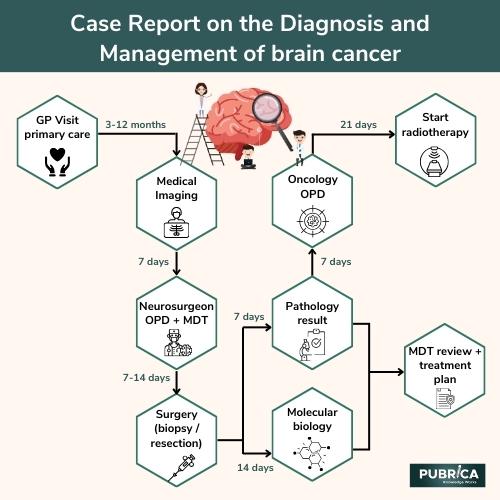
Abstract:
This case report presents the diagnosis and management of a patient with brain cancer, highlighting the complex and interdisciplinary approach involved in providing optimal care. The case underscores the importance of early detection, accurate diagnosis, and a well-coordinated treatment plan to improve outcomes for individuals facing brain cancer.
Introduction:
A brain tumor is an abnormal cell development in the brain. The architecture of the brain is extremely complicated, with several sections responsible for various nervous system processes. Brain tumors can form in any portion of the brain or skull, including the protective lining, the underside of the brain (skull base), the brainstem, the sinuses and nasal cavity, and several other locations. There are about 120 distinct forms of tumors that may grow in the brain, depending on the tissue from which they emerge.
Brain cancer, particularly glioblastoma multiforme (GBM), is a devastating disease with limited treatment options and a challenging prognosis. This case report focuses on a patient who presented with symptoms suggestive of brain cancer, emphasizing the critical steps in diagnosis and the multidisciplinary approach employed for effective management.
Case Presentation: Patient History: Mr. A, a 55-year-old male, presented with persistent headaches, seizures, and progressive neurological deficits. A detailed medical history revealed the gradual onset of symptoms over the past two months, prompting further investigation.
Diagnostic Workup:
- Neurological Examination: A thorough neurological examination identified focal deficits, raising suspicion of a central nervous system disorder.
- Imaging Studies: Magnetic Resonance Imaging (MRI) of the brain revealed a contrast-enhancing mass in the frontal lobe, indicative of a potentially malignant tumor.
- Biopsy: A stereotactic brain biopsy was performed to obtain tissue for histopathological analysis and molecular testing, confirming the diagnosis of glioblastoma multiforme (GBM).
Diagnosis: The patient was diagnosed with GBM, a high-grade and aggressive form of brain cancer. Molecular profiling of the tumour informed the treatment plan, considering the genetic characteristics of cancer.
Treatment Plan:
- Surgery: The patient underwent maximal safe resection of the tumour to reduce mass effect and enhance the effectiveness of subsequent therapies.
- Radiation Therapy: Adjuvant radiation therapy was initiated to target residual cancer cells and minimize the risk of recurrence.
- Chemotherapy: Concurrent and adjuvant temozolomide, a chemotherapy drug, was administered in accordance with the Stupp protocol.
- Immunotherapy and Targeted Therapies: Investigational immunotherapies and targeted therapies were considered based on the tumour's molecular profile, contributing to a personalized treatment approach.
Monitoring and Follow-up: Regular imaging and clinical evaluations were conducted to assess treatment response and manage potential side effects. The patient's quality of life, neurocognitive function, and emotional well-being were integral components of ongoing care.
Discussion: This case report highlights the complexity of diagnosing and managing brain cancer, emphasizing the importance of a multidisciplinary team comprising neurologists, neurosurgeons, oncologists, and radiologists. The integration of molecular profiling in treatment decisions showcases the evolving landscape of precision medicine in oncology.
Conclusion: Effective management of brain cancer necessitates a comprehensive and collaborative approach involving accurate diagnosis, aggressive treatment modalities, and continuous monitoring. Advances in molecular profiling and personalized therapies offer hope for improved outcomes, underscoring the importance of ongoing research in the field of neuro-oncology.
Acknowledgments: The authors express gratitude to the patient and their family for their cooperation and consent in sharing this case for educational purposes. Additionally, appreciation is extended to the healthcare professionals involved in the patient's care.




























